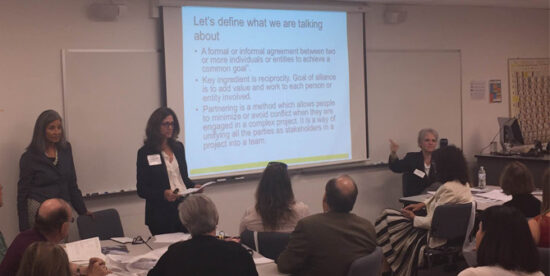
The nonprofit sector is a well-known cheerleader for strategic partnerships, as I am. The sector is collaborative by nature and often resource-challenged. Partnerships have been on my mind quite a bit of late since I helped lead the Strategic Partnerships workshop with Diane Crow from the U.S. Department of State and Felicia Naranjo Martinez from The Colorado European Union Center of Excellence at July’s Diplomacy Begins Here Summit in Denver.
Partnerships are often the best vehicle for expanding our reach, enabling us to gain the skills or expertise we need, while introducing greater efficiencies into our operations. One of the core goals of the Diplomacy Begins Here summit series was to encourage greater collaboration and partnerships for local organizations, thereby advancing our nation’s public diplomacy agenda.
Being methodical and strategic about how you seek out partnerships is necessary for success.
Encouraging collaboration and partnerships is easy. Executing them effectively, in a way that is win-win for both sides, is a challenge. Experience tells me that the rules of engagement are critical to those seeking to create new partnerships or evaluate existing ones. To help meet those challenges, allow me to share what I learned from our Denver session on strategic partnerships.
We examined how the term “partnership” means different things to different people, with tremendous variation depending on the complexity of the relationship. On one end of the spectrum is “Transactional partnerships,” in which each partner is simply looking for material gain. This type of partnership is needs-based. Each side agrees to share services, such as office space or purchasing power, but little more. Collaboration, complexity and trust are all very limited in these types of partnerships.
At the other end of the spectrum is a true alliance, which requires a high level of complexity, collaboration, and trust. Organizations engaged in these types of partnerships exert considerable influence on one another as they work together to fulfill their common vision.
Starting with a strategy, rather than a partner, is another key lesson we discussed at the Denver Summit. An organization can easily waste time and energy trying to make multiple partnerships work with no clear vision for the purpose the partnerships. One must be clear and articulate to what end a particular partnership is serving.
Partnerships are often the best vehicle for expanding our reach, enabling us to gain the skills or expertise we need
Finally, we studied how partnerships enjoy a life-cycle like almost any other relationship. Step one for establishing a new partnership: be very selective in how you evaluate your potential partners. Early on, articulate your overall partnership vision in order to enable both sides to agree to a shared purpose. Establish ground rules for the partnership, preferably in writing, to reduce misunderstandings. And an unavoidable step in the life-cycle is assessing when to either take the partnership to the next level or making the decision to retire the partnership.
Being methodical and strategic about how you seek out partnerships is a necessary ingredient for success. In general, 50 percent of partnerships succeed. But when entities approach partnerships in an ad hoc fashion, the success rate is a lowly 20 percent! On the flip side, however, those organizations that articulate a clear strategy are more often rewarded: their partnership success rate is 80 percent.
I am merely scratching the surface of what can be learned about strategic partnerships. If you’d like to read further, consider the following books I found to be helpful: Successful Partnerships and Strategic Alliances by Peter J. Simoons and Finding Allies, Building Alliances by Mike Leavitt and Rich McKeown.
By Jennifer Clinton, PhD, President, Global Ties U.S. Follow her on Twitter: @CDJclinton
